We grow tomato “Pink Miracle F1” from sowing to harvest: reviews from farmers and practical recommendations
Tomato Pink Miracle f1 is a real find for the gardener. This is an early ripening hybrid, characterized by high yield, disease resistance, ease of care and excellent fruits. Pink vegetables are considered the healthiest of all tomatoes.
The increased content of lycopene, carotene and other beneficial substances in them not only improves immunity, but also suppresses depression. And the delicious taste of ripe vegetables will not leave even the most fastidious gourmet indifferent.
Characteristics and description of the variety
Bred in Transnistria, entered into the State Register in 2010.
Bush determinant, height 100-110 cm, medium foliage. The leaves are large, light green. The inflorescences are simple. The first inflorescence is formed above 5-6 leaves, the subsequent ones - after 2 leaves. Each cluster bears 5-7 fruits.
Reference! The term “determinant” comes from the Latin word determination, which means limitation, limit.
An early ripening hybrid, 80–85 days pass from the moment of germination to full maturation. Recommended for cultivation in open ground and in greenhouse conditions.
Productivity is high, from 1 sq. m harvest up to 19 kg of vegetables.
The culture is resistant to the main diseases of the nightshade family, such as: late blight, Alternaria, Fusarium, tobacco mosaic. But it is often attacked by insect pests, such as the Colorado potato beetle.
The plant needs mandatory garter. As the branches grow, they become spreading, so it is better to fix them to a support. In addition, ripe fruits noticeably weigh down the hands, which may not support the weight of the vegetables.
Like a garter stepsoning - an obligatory step in crop care.
The fruits are even, smooth, round in shape, the color of ripe raspberries. Weight up to 120 g, thin skin, 4-6 seed chambers. The taste is excellent, a harmonious combination of sugar and sourness. The pulp is medium dense, moderately juicy.
Ripe vegetables cannot be stored for long-term storage. If transportation is planned over long distances, then it is best to transport them unripe.
The variety belongs to the salad variety, so fresh use is preferable. They make amazing summer salads, an excellent base for hot and vegetable dishes, baking vegetables with meat - all these dishes exhibit excellent taste. In pickles and marinades, tomatoes of this variety show their taste less expressively, so they are practically not used for winter preparations.
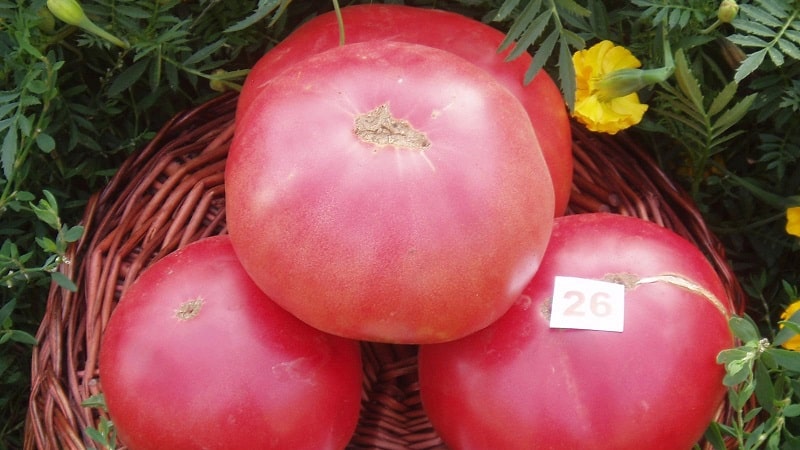
How to grow seedlings
Sowing of seeds begins 2 months before planting seedlings in the ground. The soil mixture is prepared from garden soil mixed with peat and river sand. All components are thoroughly mixed. To destroy pathogenic microflora, the soil is disinfected with a hot solution of potassium permanganate.
You can plant seeds in a common wooden box or in individual containers: plastic and peat pots. Before sowing, lightly moisten the soil with a spray bottle. Seeds are planted at a depth of 1.5 cm with a distance of 2 cm from each other.After sowing, the containers are covered with glass or film and left in a warm and bright room at an air temperature of at least 23 ° C.
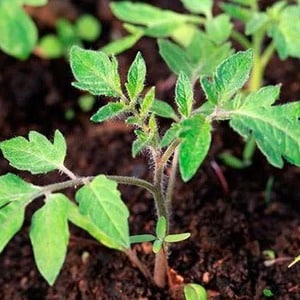 When the first shoots appear seedlings Move to a more illuminated place, for example, on a windowsill. Daylight hours should be at least 14 hours long. If there is not enough natural light, then they are illuminated with ordinary lamps.
When the first shoots appear seedlings Move to a more illuminated place, for example, on a windowsill. Daylight hours should be at least 14 hours long. If there is not enough natural light, then they are illuminated with ordinary lamps.
When 2 true leaves appear, the seedlings dive, planting them in separate containers. If the grains are sown in individual plastic cups, the sprouts are transplanted into larger containers.
Water as the top layer of soil dries out. Water moderately with warm, settled water. After watering, loosening is carried out with a wooden stick - superficially, so as not to disturb the root system.
After 2 weeks, make the first fertilizing with nitrophoska. If the sprouts develop poorly, they are additionally fed with sodium humate.
2 weeks before planting the seedlings in the ground, the seedlings begin to harden. They are taken outside for several hours, and the night temperature, where the seedlings remain until the morning, is reduced to 13 °C.
How to grow tomatoes
After 2 months, the seedlings are ready to be transplanted to a permanent location. The land for planting is prepared in advance, in the fall, by feeding it with organic fertilizers. Then the soil is dug up and all weeds are removed.
Planting pattern: 70 cm - distance between seedlings, 40 cm - between rows. Half a glass of wood ash and a pinch of potassium fertilizer are added to the prepared holes and filled with water. After planting, the seedlings are watered again, the soil is loosened, hilled and mulched.Loosening provides better access of oxygen to the roots, and mulching retains moisture in the beds, so the bushes are watered less often.
Regular watering is established as the sprouts take root in a new place, but not more than 2 times a week. Water moderately with warm, settled water, strictly at the root. After each watering, the soil is loosened, removing weeds with roots.
The crop is fed with organic matter twice per season. This is quite enough to improve the growth and development of the plant during the ripening period. Dilute mullein with water 1:10 or chicken manure 1:15, leave for a week, and then pour 1 liter under each plant.
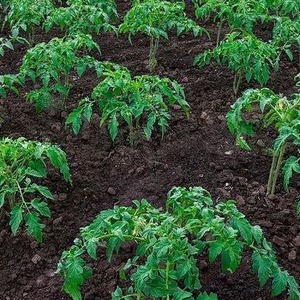 Pruning is carried out to avoid excess green mass. Density leads to the development of fungal diseases, lack of sunlight, and with a large amount of greenery, it is easy to miss pests, which will lead to their successful reproduction.
Pruning is carried out to avoid excess green mass. Density leads to the development of fungal diseases, lack of sunlight, and with a large amount of greenery, it is easy to miss pests, which will lead to their successful reproduction.
If you remove excess shoots from the main stem in time, nutrients are spent on the formation of fruits, and not on the growth of unnecessary green mass. The plant is formed into 2-3 stems.
Gartering of tall bushes is required. Bushes are tied up at an early age to form a strong and even stem. The branches are also fixed to the supports, otherwise they will not support the weight of ripe fruits. A support is installed next to each bush when planting. These can be wooden stakes or metal rods.
Reference! Tomatoes cannot be planted in soil where crops of the nightshade family previously grew. This is due to the fact that they pull the same nutrients from the ground: the tomato crop will not receive enough minerals and vitamins necessary for growth and development.In addition, the likelihood of developing diseases common to nightshades increases.
Diseases and pests
Hybrid crops are characterized by increased immunity to major diseases, and the Pink Miracle f1 tomato is no exception. The main pest of vegetable crops is the Colorado potato beetle. Female beetles lay eggs on the inside of leaves, so it is important to inspect the undersides of leaves.
This pest is collected by hand and burned together with the larvae in glass jars. The beetle eats the leaves of plants of the nightshade family, which leads to their wilting. If the parasite is found in the garden beds, all crops need to be inspected, not just tomatoes.
Slugs also cause damage to tomatoes. To prevent their invasion, the beds are sprinkled with tobacco dust. Slugs are attracted to the smell of beer, and experienced gardeners set up beer traps in their gardens.
The culture does not like high humidity and rainy weather. During the wet season, they are treated with fungicidal and biological preparations. This prevents the development of fungal diseases such as late blight, various rot and mold.
The nuances of growing in open ground and in a greenhouse
In the southern regions, the variety is grown in open ground; in cold regions it is recommended to grow it in heated greenhouses.
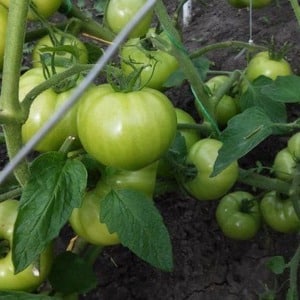 Greenhouse fruits ripen earlier than in open beds. Outdoors, the ripening of vegetables is influenced by:
Greenhouse fruits ripen earlier than in open beds. Outdoors, the ripening of vegetables is influenced by:
- temperature;
- number of sunny days;
- amount of precipitation.
The height of greenhouse plants is slightly higher than those planted in open ground. To limit growth, pinching the crown is carried out.
In the greenhouse, not only does the fruit ripen faster, but the quantitative indicator is also higher. However, greenhouse plants are more susceptible to fungal diseases and spider mite attacks. Therefore, it is necessary to regularly ventilate indoor structures to keep plants healthy throughout the season.
If the crop is planted in regions with a temperate climate in open beds, it is necessary to have some kind of covering material on hand to protect it in case of unexpected cold weather or heavy rains.
Harvesting and application
The ripening of vegetables begins in June, the fruits ripen together, which makes them easier to harvest.
Tomatoes can be picked unripe; they are quite capable of gaining color on their own, without losing their taste.
 The tomato variety belongs to the salad variety, therefore, first of all, they are used fresh. Tomatoes are good in any salad, and they complement other vegetables perfectly. They are used to prepare hot and vegetable dishes, and are used in baking with meat.
The tomato variety belongs to the salad variety, therefore, first of all, they are used fresh. Tomatoes are good in any salad, and they complement other vegetables perfectly. They are used to prepare hot and vegetable dishes, and are used in baking with meat.
This type is not suitable for pickling and marinades, but it can be used to make tomato products, for example, juice or paste. True, the color of tomato juice will be paler. For rich color, pink tomatoes are mixed with red ones.
Ripe vegetables cannot be stored for long periods of time. They are either eaten immediately or made into canned salads.
The difference between these tomatoes is their high yield of marketable mass. Vegetables are transported over short distances with the possibility of quick sale.
Advantages and disadvantages of the variety
Early-ripening raspberry-colored tomatoes are always in demand on the market, despite the fact that they are practically unsuitable for winter harvesting. However, they are so fortified that they help improve immunity. In addition, they are ideal for those who cannot eat red vegetables due to allergies.
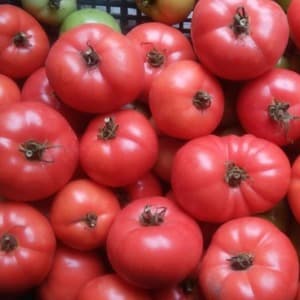 Advantages of the variety:
Advantages of the variety:
- ease of care;
- early maturing hybrid;
- high fruiting rate;
- resistance to major diseases;
- excellent taste of fruits;
- high content of vitamins;
- attractive presentation;
- high consumer demand;
- Possibility of breeding for sale.
Among the disadvantages of this culture, several factors are noted:
- Garter required;
- stepsoning required;
- inability to independently select seeds for the next planting;
- short shelf life;
- limited scope of application on the farm.
Farmer reviews
The opinion about the hybrid is equally positive both among entrepreneurs who are engaged in breeding any crop on an industrial scale, and among ordinary summer residents - amateurs who want to pamper themselves with unusual tomatoes:
Tatiana, Balakovo: “I grew the Macedonian pink miracle for the first time. At first the tomato was under cover, and then the film was removed. I was not sick, the ripening progressed smoothly, the fruits were sweet and soft. I liked it"
Valentina, Nizhny Novgorod region: “I grew it in a greenhouse. The bush led into 1 trunk, grew short, but prolific. There are 3-4 tomatoes on the branches, the weight reached up to 150 g. Very tasty.”
Vera, Krasnodar Territory: “My favorite tomato. Grows quickly. The fruits are not large, but aromatic. They sell well and are among the first to ripen.”
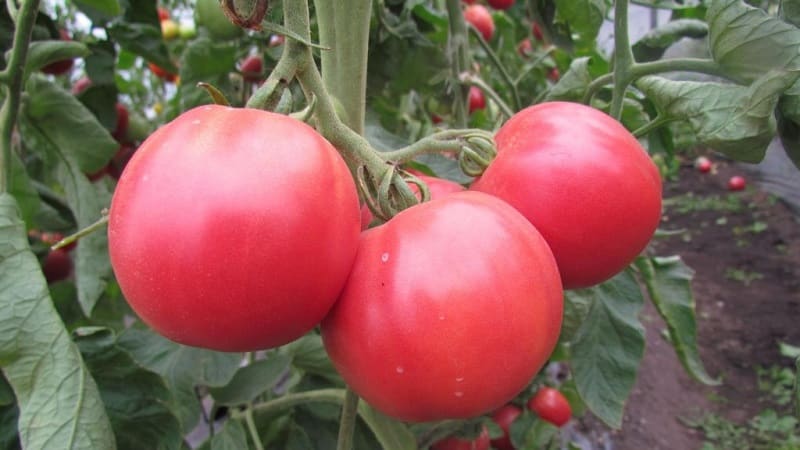
Conclusion
Tomato Pink Miracle f1 confidently occupies a leading position not only in markets in all regions of Russia, but also in the beds of most summer cottages. The culture has proven itself to be disease-resistant, high-yielding, and unpretentious in care.And the early ripening period allows you to make summer salads from tomatoes grown in your garden, while late-ripening varieties are just setting green fruits.